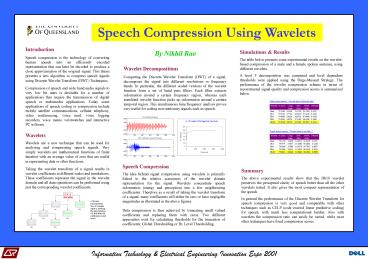Speech Compression Using Wavelets PowerPoint PPT Presentation
1 / 1
Title: Speech Compression Using Wavelets
1
Speech Compression Using Wavelets
Introduction Speech compression is the
technology of converting human speech into an
efficiently encoded representation that can later
be decoded to produce a close approximation of
the original signal. This thesis presents a new
algorithm to compress speech signals using
Discrete Wavelet Transform (DWT)
Techniques. Compression of speech and wide band
audio signals to very low bit rates is desirable
for a number of applications that require the
transmission of digital speech or multimedia
applications. Today some applications of speech
coding or compression include mobile satellite
communications, cellular telephony, video
conferencing, voice mail, voice logging
recorders, voice memo wristwatches and
interactive PC software. Wavelets Wavelets are a
new technique that can be used for analyzing and
compressing speech signals. Very simply wavelets
are mathematical functions of finite duration
with an average value of zero that are useful in
representing data or other functions. Taking
the wavelet transform of a signal results in
wavelet coefficients at different scales and
translations. These coefficients represent the
signal in the wavelet domain and all data
operations can be performed using just the
corresponding wavelet coefficients.
Simulations Results The table below presents
some experimental results on the wavelet-based
compression of a male and a female spoken
sentence, using different wavelets. A level 3
decomposition was computed and level dependent
thresholds were applied using the Birge-Massart
Strategy. The performance of the wavelet
compression scheme in terms of reconstructed
signal quality and compression scores is
summarised below.
By Nikhil Rao
Wavelet Decompositions Computing the Discrete
Wavelet Transform (DWT) of a signal, decomposes
the signal into different resolutions or
frequency bands. In particular, the different
scaled versions of the wavelet function form a
set of band pass filters. Each filter extracts
information around a certain frequency region,
whereas each translated wavelet function picks up
information around a certain temporal region.
This simultaneous time/frequency analysis proves
very useful for coding non-stationary signals
such as speech.
Speech Compression The idea behind signal
compression using wavelets is primarily linked to
the relative scarceness of the wavelet domain
representation for the signal. Wavelets
concentrate speech information (energy and
perception) into a few neighbouring coefficients.
Therefore as a result of taking the wavelet
transform of a signal, many coefficients will
either be zero or have negligible magnitudes as
illustrated in the above figures. Data
compression is then achieved by truncating small
valued coefficients and replacing them with
zeros. Two different approaches exist for
calculating thresholds for the truncation of
coefficients Global Thresholding or By Level
Thresholding.
Summary The above experimental results show that
the Db10 wavelet preserves the perceptual clarity
of speech better than all the other wavelets
tested. It also gives the most compact
representation of the speech. In general the
performance of the Discrete Wavelet Transform for
speech compression is very good and comparable
with other techniques such as CELP (code excited
linear predictive coding) for speech, with much
less computational burden. Also with wavelets the
compression ratio can easily be varied, while
most other techniques have fixed compression
scores.
A Wavelet Decomposition Tree of a sample signal
S, showing the approximation cAj and detail cDj
coefficients at each level j.

